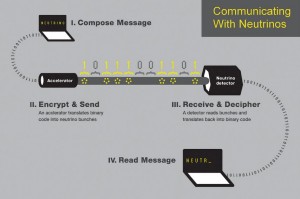The Neutrino Network

With 802.11n, you can see Wi-Fi networking speeds above 100 Megabits per second (Mbps) with a range up to 70-meters. With the just shipping now 802.11ac, you can get more than a Gigabit per second (Gbps) speeds with a range of about 35-meters. 802.11ad, which is still coming together, may give us 7Gbps speed but at a range of only five-meters. Or, if laboratory experiments by University of Rochester and North Carolina State University work out, we may someday be able to use neutrino networks at ranges of tens of thousands of kilometers.
Scientists from the school were able to use neutrinos--nearly massless particles that travel at almost the speed of light--to send the binary message "Neutrino" to a receiver that was just over a kilometer away and that included 240 meters of stone in the way." Try that with any other wireless technology!
In a statement, Dan Stancil, professor of electrical and computer engineering at NC State and lead author of Demonstration of Communication using Neutrinos, said, "Using neutrinos, it would be possible to communicate between any two points on Earth without using satellites or cables. Neutrino communication systems would be much more complicated than today's systems, but may have important strategic uses."
What neutrinos can do, that electromagnetic communications can't do, is penetrate almost anything they encounter. With their neutral electric charge and almost non-existent mass, neutrinos are not subject to magnetic attractions and are not significantly altered by gravity, so they are virtually free of any possible interference. With neutrino communications or networks we could talk or hook up wirelessly with anyone on Earth or, for that matter, the far side of the moon.
Of course, this is a long, long way from being something you can buy from Cisco! Kevin McFarland, a University of Rochester physics professor who was involved in the experiment, explained "Our current technology takes massive amounts of high-tech equipment to communicate a message using neutrinos, so this isn't practical now. But the first step toward someday using neutrinos for communication in a practical application is a demonstration using today's technology."
The scientists demonstrated that it was possible at the Fermi National Accelerator Lab. There they used one of the world's most powerful particle accelerators to create high-intensity beams of neutrinos by accelerating protons around a 2.5-mile-circumference track and then colliding them with a carbon target. With it they generated a message, which was detected by a multi-ton detector called MINERvA, which is located in a near-by cavern 100 meters underground. You won't be seeing this in an iPad anytime soon.
Of course, at a speed of 0.1 kilobit per second (Kbps), and the need for a particle accelerator and a multi-ton detector to make it work we have as Deborah Harris, Minerva project manager, put it "long way to go before it will be as effective." Still, literally limitless range wireless communications is just too attractive an idea not to eventually be turned into a government communications system and then commercial products if there's any way it can possibly be done.
Related Stories:
802.11ac: Gigabit Wi-Fi Devices will be shipping in 2012
Wires? We don't need no stinking Wires! Gigabit Wi-Fi
